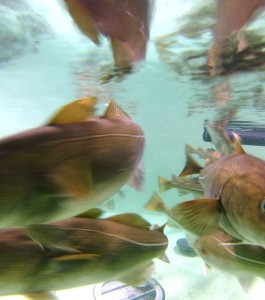
A fin whale found on an Alaskan beach in 2015 might have been among the victims of The Blob. BREE WITTEVEEN
ScienceMag.org By Warren Cornwall, January 21st, 2019
When marine biologist Steve Barbeaux first saw the data in late 2017, he thought it was the result of a computer glitch. How else could more than 100 million Pacific cod suddenly vanish from the waters off of southern Alaska?
Within hours, however, Barbeaux’s colleagues at the National Oceanic and Atmospheric Administration (NOAA) in Seattle, Washington, had confirmed the numbers. No glitch. The data, collected by research trawlers, indicated cod numbers had plunged by 70% in 2 years, essentially erasing a fishery worth $100 million annually. There was no evidence that the fish had simply moved elsewhere. And as the vast scale of the disappearance became clear, a prime suspect emerged: “The Blob.”
In late 2013, a huge patch of unusually warm ocean water, roughly one-third the size of the contiguous United States, formed in the Gulf of Alaska and began to spread. A few months later, Nick Bond, a climate scientist at the University of Washington in Seattle, dubbed it The Blob. The name, with its echo of a 1958 horror film about an alien life form that keeps growing as it consumes everything in its path, quickly caught on. By the summer of 2015, The Blob had more than doubled in size, stretching across more than 4 million square kilometers of ocean, from Mexico’s Baja California Peninsula to Alaska’s Aleutian Islands. Water temperatures reached 2.5°C above normal in many places.
By late 2016, the marine heat wave had crashed across ecosystems all along North America’s western coast, reshuffling food chains and wreaking havoc. Unusual blooms of toxic algae appeared, as did sea creatures typically found closer to the tropics (see sidebar). Small fish and crustaceans hunted by larger animals vanished. The carcasses of tens of thousands of seabirds littered beaches. Whales failed to arrive in their usual summer waters. Then the cod disappeared.
The fish “basically ran out of food,” Barbeaux now believes. Once, he didn’t think a food shortage would have much effect on adult cod, which, like camels, can harbor energy and go months without eating. But now, it is “something we look at and go: ‘Huh, that can happen.’”
Today, 5 years after The Blob appeared, the waters it once gripped have cooled, although fish, bird, and whale numbers have yet to recover. Climate scientists and marine biologists, meanwhile, are still putting together the story of what triggered the event, and how it reverberated through ecosystems. Their interest is not just historical.
Around the world, shifting climate and ocean circulation patterns are causing huge patches of unusually warm water to become more common, researchers have found. Already, ominous new warm patches are emerging in the North Pacific Ocean and elsewhere, and researchers are applying what they’ve learned from The Blob to help guide predictions of how future marine heat waves might unfold. If global warming isn’t curbed, scientists warn that the heat waves will become more frequent, larger, more intense, and longerlasting. By the end of the century, Bond says, “The ocean is going to be a much different place.”



